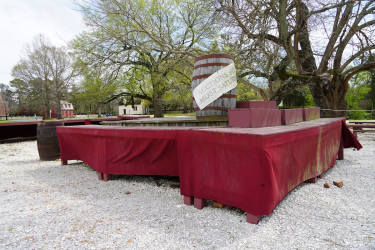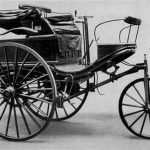Article by Peter Koeppel, member of Trinity Memorial Church in Binghamton. Koeppel serves on the diocesan Stewardship Resources team and the diocesan Creation Care Initiative and is a frequent contributor on the topics of creation care, stewardship, and racial justice and reconciliation.
In the north-east corner of the public market square in Colonial Williamsburg, VA, there is an unassuming collection of tables, painted ox-blood red, and draped in red cloth. If you look at them from close up, you’ll notice that they form a rough rectangle, with some somewhat higher tables inside and near the perimeter of the rectangle. They’re easy to overlook, but once you’ve seen them, you cannot possibly ever unsee them again. On that higher set of tables is a barrel with a sign: “Auctions here most Saturdays.” This, of course, is an auction block for enslaved persons.

An auction block for enslaved persons in Colonial Williamsburg, VA. Photo by P. Koeppel.
Therein lies one of several history lessons you should think about taking with you from any visit to Colonial Williamsburg: watching and interacting with the highly skilled crafts- and tradespeople in this living museum is fun and educational, but if you’re honest, you have to acknowledge that what you’re seeing is a highly filtered view of life in 18th century Williamsburg: what you see is how the upper middle-class lived and worked, what you don’t see is the economic and social foundation which enabled the upper middle class to enjoy the lives they lived.
Another important marker stands near Williamsburg’s 107 N. Boundary Street. The marker reads: “The Associates of Dr. Bray, a London-based charity, founded a school for enslaved and free black children here in 1760. Located in Williamsburg at the suggestion of Benjamin Franklin, a member of the Associates, the school received support from the College of William & Mary. Anne Wager instructed as many as 400 boys and girls during her 14 years as teacher. In a culture hostile to educating African Americans, Wager taught the students principles of Christianity, deportment, reading, and, possibly, writing. The curriculum reinforced proslavery ideology but also spread literacy within the black community. The school moved from this site by 1765 and closed in 1774.
The small, two-story building that housed the school still exists, much modified since its use as a school, has recently been identified, and by agreement between the College of William and Mary and the Colonial Williamsburg Foundation will be relocated to the Foundation’s Historic District.
The statement that really took my breath away is in the next to last sentence on the marker’s text: “The curriculum reinforced proslavery ideology…” I probably should have expected that, but seeing it stated this unequivocally was a brutal reminder of what life in Virginia back then was like. The genteel lives, which were not easy by modern living standards, of the upper middle class, who make up the majority of the living museum, did not shy away from ensuring that young Black children—free or enslaved—knew their place in society. For them, no aspiration of “all men being equal,” all men being entitled “to the pursuit of life, liberty and happiness.” Instead, theirs were the backs on which society built its life.
Here we are, centuries and a painful civil war later, and not only does it appear as if we have made only limited progress on acknowledging that “all men” does include men, women, children, human beings of all backgrounds and kinds, but that we’re still fighting those battles today. Not necessarily with sabers, guns, and cannons but with statues, statutes, and declarations, such as Mississippi Governor Tate Reeves declaring April 2022 being “Confederate Heritage Month.” In March 2022, he also issued a declaration against genocide—he’s against it, of course. But he fails to acknowledge in his list of historical genocides that of the native peoples of what became the USA. This genocide and the institutional racism of slavery constitute the two original sins of what became the USA, standing in stark contrast with the aspirational declarations on which the USA were founded.
To be able to truly deal with the continuing effects of these two original sins, it is necessary that we fully accept that they were perpetrated. Accepting and acknowledging the history of white European settlement in what became the USA does not mean that we embrace this history. But if we don’t accept that it happened, and that its tentacles reach across time straight down into our daily lives, we will only be perpetuating it, instead of allowing for repentance, allowing for the healing necessary.
The plain statement on the Bray School marker, as hard as it hit me, was one important acknowledgement of history—and we need many more such statements—on which we can start to build our repentance.


